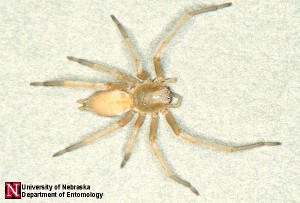
Yellow sac spiders
Yellow sac spiders (Cheiracanthium inclusum and C. mildei)
The following is taken from the Pennsylvania State University, Department of Entomology web site entitled, Commonly Encountered Pennsylvania Spiders (and two rarely encountered but medically important species).
Yellow sac spiders can be found walking about on foliage; under leaf litter, stones, and boards; and on buildings under the window sills and siding, in addition to the corners of walls and ceilings within homes. They probably account for more spider bites than any other spider and their bites are sometimes misdiagnosed as brown recluse bites by health care providers. C. inclusum is indigenous to much of the United States (except the northernmost states), while C. mildei, an introduced species from Europe, was found throughout much of the Northeast as of 1978. It is likely that C. mildei has substantially increased its range since that time.
Description: Both species are of similar size (females 5-10 mm; males 4-8 mm) and coloration. C. inclusum is a light yellow to cream color, with the jaws (chelicerae), tips of the tarsi, and palps dark brown. C. mildei has a slightly greenish tinge to its abdomen and a pale yellow cephalothorax. The chelicerae, tarsi, and palps are similar to those of C. inclusum. Both spiders have a slightly darker dorsal stripe running lengthwise across the abdomen.
Yellow sac spider retreats may be found outdoors under objects or indoors in the corners of walls and ceilings. These retreats are silken tubes or sacs in which the spiders hide during the daytime. In homes with light, neutral-colored walls and ceilings, the retreats may go unnoticed, as they are small and blend in with the background coloration.
Life History: Yellow sac spiders deposit their eggs in June or July. The eggs are loosely deposited within a silken retreat, and the female remains nearby to guard them. C. inclusum is more often encountered outside; the majority of these spiders deposit their eggs on the undersides of leaves or other foliage. C. mildei is more often encountered within man-made structures and oviposits almost exclusively indoors. The young spiderlings will often remain within the silken retreat for a short period and eventually venture out at night in search of food. The young will frequently return at daybreak to hide within the protection of the retreat.
Yellow sac spiders are “active hunters,” searching for prey rather than capturing it within a web. It is during these nighttime forays that the spiders encounter humans and bite when they become trapped between a person’s skin and sheets, clothing, shoes, and the like.
Medical Importance: The yellow sac spiders probably account for more human bites that any other type of spider. The bite of C. inclusum is more destructive then the bite of C. mildei. Humans usually incur C. inclusum bites outdoors while gardening in the summer. C. mildei will readily bite, despite their small size, and they have been observed crawling across the human skin surface and biting without provocation. Fortunately, most bites are relatively painless and do not result in any serious medical conditions. For C. inclusum victims and some individuals sensitive to C. mildei, the bites will exhibit the symptoms described below.
The bite is usually very painful at the outset, with developing erythema, edema, and pruritus. The burning sensation associated with the bite will last for up to an hour, with rash and blistering occurring during the next 1-10 hours. Some patients may exhibit systemic reactions with fever, malaise, muscle cramps, and nausea. These symptoms are similar to black widow bite symptoms but are much less severe. A necrotic lesion and ulceration may also occur at the site, but this is less serious than the similar symptoms that accompany a brown recluse bite, and it usually does not result in scarring.




 Print
Print Email
Email




